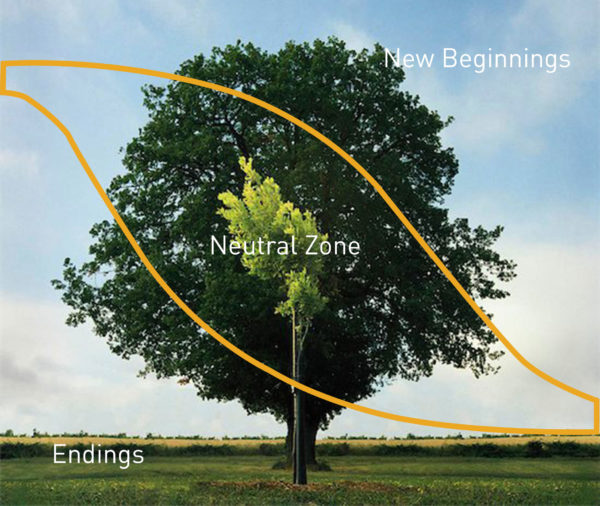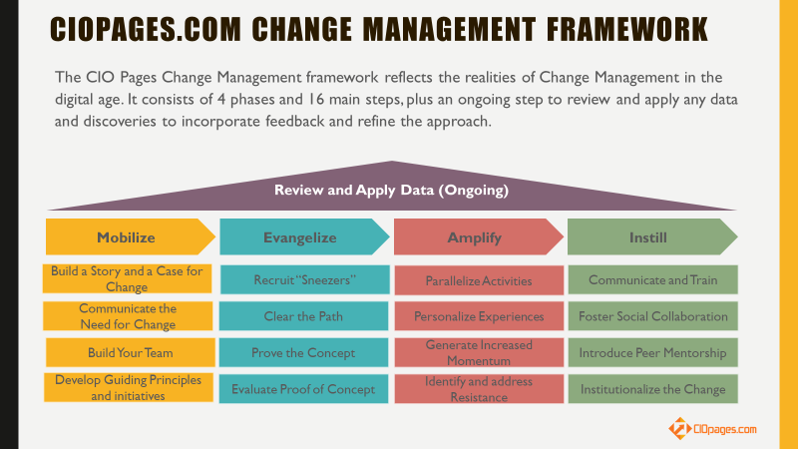Top Ten Change Management Models
By: Ciopages Staff Writer
Updated on: Feb 25, 2023
What are Change Management Models?
Change Management Models are frameworks which encapsulate a foundational concept, a methodology, a content metamodel, and an in-depth approach to achieving the transformation change objectives and foster adoption and acceptance of the new desired state. Think of change management models as a guide or a compass to navigate and institute transformational change.
In this article, you will find an introduction to the top ten change management models and exploration of the underlying theory and practice.
An enterprise may choose from one of the top ten change management models or mix and match elements from more than one model. Each model employs a unique approach to instituting change and make enterprise transformations stick. A variety of change management models exist, and one may fit a particular organization business structure better. Most change management models were created by industry experts or academics and are a combination of academic/field research and/or experience.
People don’t resist change. They resist being changed! – Peter Senge, Author of The Fifth Discipline
What is Change Management?
Change management is a proven methodology used to help organizations successfully implement a substantial transformation or set of changes. (To level set, here is the Change Management Definition and an overview of Change Management by CIOPages.com.)
Harvard Business Review states that the goal of change management is to “cope with a new, more challenging market by changing the way business is conducted.” Of course, successful implementation of the intended changes and meeting all intended objectives is what’s critical. Change management may be used to alter anything from the organizational structure or business environment to technology or job roles.
Top Ten Change Management Models:
Now let’s delve into each of the top ten change models and explore the concept, the underpinning theory, and the applicability.
He who rejects change is the architect of decay.
~Harold Wilson, former Prime Minister of United Kingdom
Lewin’s Change Management Model
One of the most popular and successful change management models, Lewin’s Change Management Model act by Kurt Lewin, a social scientist, and physicist in the 1940s. Lewin was interested in what factors or forces are influencing a situation at any given time — notably, social situations. He aimed to determine the effects either hindered movement toward a goal or drove the move toward a given unfreezing. He is mostly considered the founder of change management.
Lewin defined any change in a human system as “changing as three steps” or CATS. The three steps are 1. Unfreeze 2. Change, and 3. Refreeze:
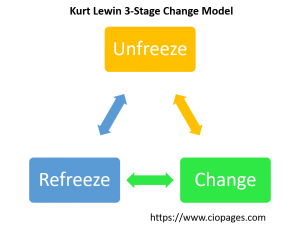
Unfreeze
Unfreeze is a preparatory phase that helps those who will be affected by the transition to break down the current status quo and accept that change is imminent. Key here is noting the reasons why the current state is flawed and cannot continue.
Change
During this step, the simplicity of time, as well as excellent communication, are used to implement change. Where the unfreeze stage can be stressful, the change stage continues to be somewhat stressful, but it moves forth regardless with support and constant communication. During this phase, rumors are dispelled, and everyone is empowered to act.
Refreeze
Finally, a refreezing phase must take place to “set in stone” the changes that were initiated in the “Change” phase. Strategies are developed to help anchor these changes so that they do not disappear or lapse into old ways. Successes are celebrated, and communication and support continue.
The McKinsey 7-S Model
Perfect for organizations that aren’t exactly sure how they need to change but know that something is amiss, the McKinsey 7-S Model is yet another standard model for organizational change. McKinsey consultants Tom Peters and Robert H. Waterman, Jr. proposed the model in their seminal book, “In Search of Excellence.”
Essentially, the model centers on seven core elements that all organizations must possess to perform well. Organizations can reference these elements to see where change and realignment are necessary or to ensure mutual reinforcement of each element to maintain quality performance. The seven elements are:
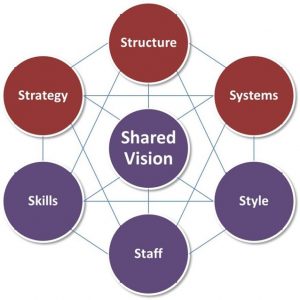
This model aims to help organizations ensure the alignment of these core elements:
Shared Values: The central values of an organization
Skills: The major capabilities and competencies of the organization
Staff: The characteristics of all key working roles, including demographic, attitude, and education
Style: Behavior patterns of all work divisions
Strategy: The overall purpose of the organization and how it aims to surpass the competition
Structure: The structural division of work within the organization
Systems: Defined procedures for resource allocation, measurement, and reward
In times of rapid change, experience could be your worst enemy.
~J. Paul Getty, Oil Tycoon
Kotter’s Theory
Kotter’s Theory of change management does not as much focus directly on the change as it does put the spotlight on the people who will need to change and who will be most affected. Still, a “top-down” methodology is employed. This model was developed by Dr. John Kotter, a Harvard professor, business and management thought leader, entrepreneur, and author. His change management model consists of eight steps:
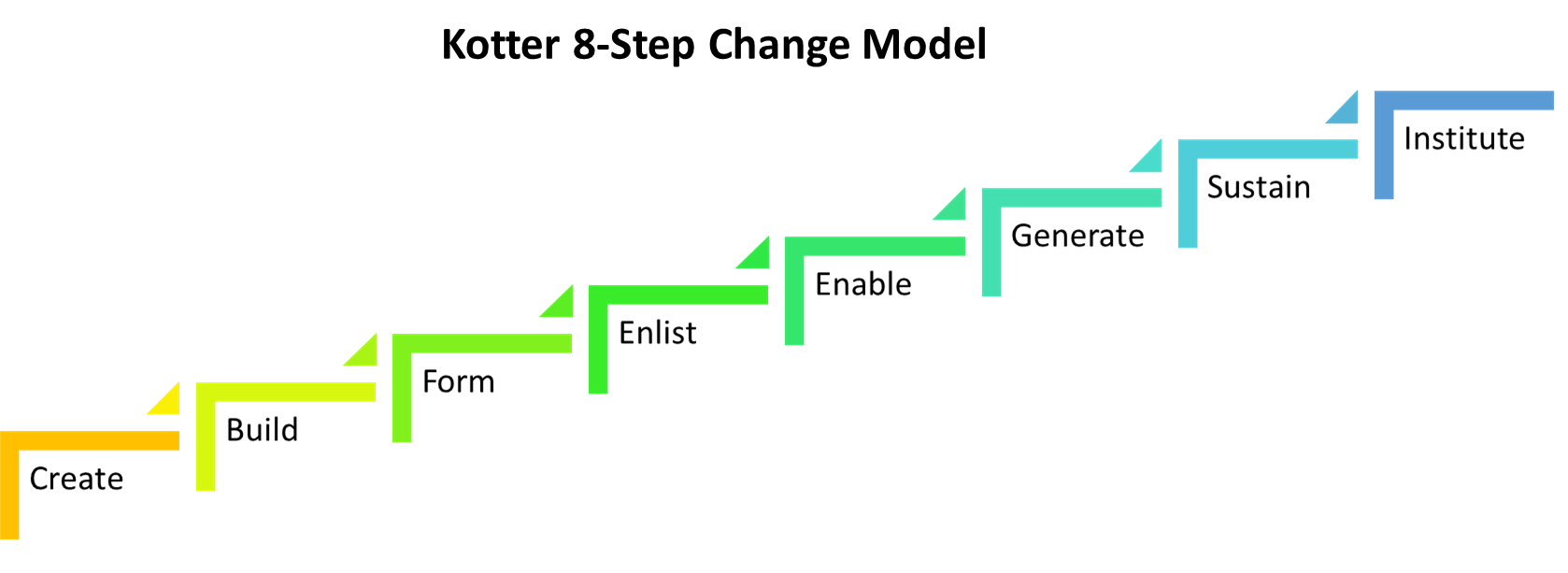
1. Create a sense of urgency: Help others see why change is needed right away through a “bold, aspirational opportunity statement.”
2. Build a guiding coalition: Enlist key players, including stakeholders and leaders.
3. Form a strategic vision and initiatives: Define your intended changes.
4. Enlist a volunteer army: Get everyone else on board and driven to implement necessary change.
5. Enable action by removing barriers: Identify and remove barriers that would otherwise be roadblocks to freedom and effective change.
6. Generate short-term wins: Track progress and energize participants through the next celebration of even small successes.
7. Sustain acceleration: After the initial successes, continue to press on the initiative of change until your goals are met.
8. Institute change: Identify the new behaviors that have been positive, and continue to express them so that they build strength and old habits don’t reappear.
___________________________________________________________________________
Change Management Models Related Offerings from our Partners:
Science of Successful Organizational Change
Managing your Team through Change
Financial Times Change Management Briefing
Fundamentals of Change Management
___________________________________________________________________________
Nudge Theory
Unlike other methods of change listed here, nudge theory possesses no set model of change. It is a theory based on behavioral science that proposes tactics and mindsets to institute a change in behavior. The essential core of the theory is that enforcing change in the traditional, methodical sense is not effective. Nudging change along, however, can be highly effective.

Some of the critical aspects of “nudging” for change include making “nudges” subtle, educational, optional, open-minded, open to discussion, indirect, and backed up with evidence. Mostly, this theory is a bit vague, but the most basic principles are outlined in Process.St like this:
- Define your changes
- Consider changes from your employees’ point of view
- Use evidence to show the best option
- Present the change as a choice
- Listen to feedback
- Limit obstacles
- Keep the momentum up with short-term wins
The path of least resistance is the path of the loser.
~H. G. Wells
ADKAR Model for Change
Jeff Hiatt of Prosci Change Management created the ADKAR Model of Change. The basis for this model comes from long-term research that Hiatt and his team conducted in more than 900 organizations who were transitioning through a change. According to this model, the emphasis must be placed on each being able to transition (change) successfully, and there are five outcomes necessary for accomplishing this:
Awareness
Focus on the recognition of the need for change. It necessitates early communication.
Desire
Leadership sponsorship of the intended changes and resistance management help facilitate desire for change within the working body.
Knowledge
Coaching and training help develop a keen understanding of how to change.
Ability
Time, practice and coaching facilitate ability in realizing the changes that are intended for the organization at the desired performance level.
Reinforcement
Finally, recognition of success and corrective action for possible failures help to reinforce changes and make them permanent.
Bridges’ Transition Model
This model was created by William Bridges, a change consultant, in his book, Managing Transitions (1991). The model puts the focus not on change, but the transition. Key here is that transition is internal and occurs more slowly than change. It also occurs within the mind. Alternatively, change is external; it happens to someone. It also occurs rather quickly.
There are three stages of transition in this model.
Stage #1: Ending, Losing, and Letting Go
All transitions begin with an ending. During this stage, people identify what is ending, what they are losing, and how to let go of these losses.
Stage #2: The Neutral Zone
This stage embodies a segment of time in which the old has passed away, but the new is still not fully in operation. It’s not a comfortable stage, but it’s necessary and acts as a “seedbed” where new beginnings can grow.
Stage #3: The New Beginning
This step is where new understandings, values, and attitudes are adopted. Impacted individuals have new roles, and they understand their purpose and how they contribute to the overall goals of the organization.
Kübler-Ross’ Change Curve
Elisabeth Kübler-Ross was a world-renowned psychiatrist and creator of the “Change Curve” as well as the “The Five Stages of Grief,” which she outlined in her book, On Death and Dying.
Both methodologies intend to help individuals and groups accept change emotionally as well as materially or physically. As such, Like Kotter’s Theory, the Change Curve model puts the focus on people, who — in any organization — are ultimately those responsible for actually implementing change. Both the Change Curve and the Five Stages of Grief are mostly the same:
Denial: Occurs when employees resist admitting that change needs to happen and necessitate intense communication and a slow transition into change
Anger: Occurs when people grow fearful and resentful of change, and requires acceptance of this outrage, additional dialogue, and support
Bargaining: Occurs when employees attempt to change the intended changes and requires listening to this feedback while remaining on firm on essential parts of the transformation
Depression: Occurs when employees slow productivity because of a sour or despaired mood toward change, and necessitates limiting friction in activities and implementing rewards for small successes
Acceptance: Occurs when change is fully implemented, and requires celebration of this recognition as well as continuing to instill the changes
The Satir Change Management Model
This model is similar to the Kübler-Ross model, but the progression through change (grief or emotional transition) are offered through a model of performance, which makes them considerably more useful for business purposes.
The model puts the focus on tracking process, which will effectually change performance over time. Instead of instigating the changes, the five stages are meant to be plotted or graphed over time:
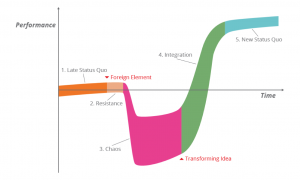
Late Status Quo
This defines the starting point before the change. What is the current state of performance, technology, morale, etc.?
Resistance
Resistance occurs when employees react with negative emotions to change. What exactly are employees resistant to? What new elements are causing this resistance and why?
Chaos
This stage occurs at the lowest point of morale and motivation and the height of resistance to change.
Integration
Here, productivity takes a positive turn, and enthusiasm begins. As with all stages, tracking performance and success is vital.
New Status Quo
Finally, a new “normal” should be implemented. The change has become “normal,” and ideally, higher and better performance result.
Maurer 3 Levels of Resistance and Change Model
Finally, we have the Maurer 3 Levels of Resistance and Change Model. This model was established by Rick Maurer and outlines the three levels of resistance that any organization will face when attempting to implement a severe change.
Maurer contents that up to two-thirds of significant changes will fail when organizations attempt to implement them. To understand why these common failures occur, Maurer poses that you must know what has caused resistance. He identifies three critical levels of resistance:
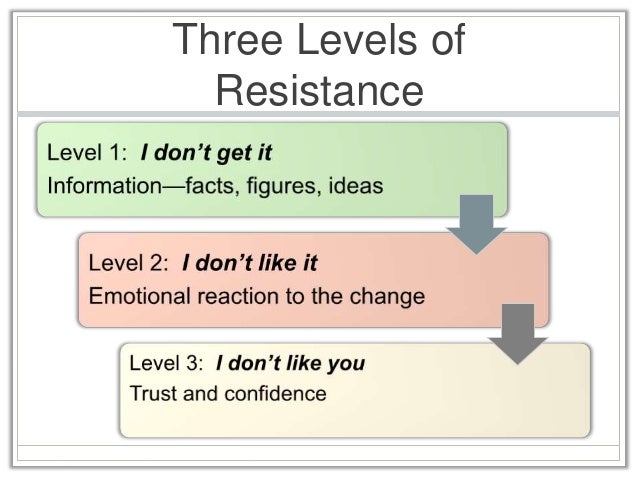
I don’t get it.
This resistance occurs when employees haven’t received enough information, disagree with the data, have a lack of exposure to critical information, or have confusion over what the data and information mean for them.
I don’t like it.
This is an emotional reaction to change that occurs when employees feel jilted, fearful, or upset that they’re being forced to alter their routines, habits, and/or job roles.
I don’t like you.
Finally, many employees take another emotional tack with resistance, putting the negativity on the people instigating the change as opposed to on the actual changes themselves.
CIOPages.com Change Management Model:
CIOPages.com offers a change management model which is free to use. For more details, please check out the CIOPages.com Change Management Framework.
Which of the change management models have you used for your enterprise transformation? What were the challenges and results during the change process?
Products Related to Change Management Models:
Articles Related to Change Management Models:

